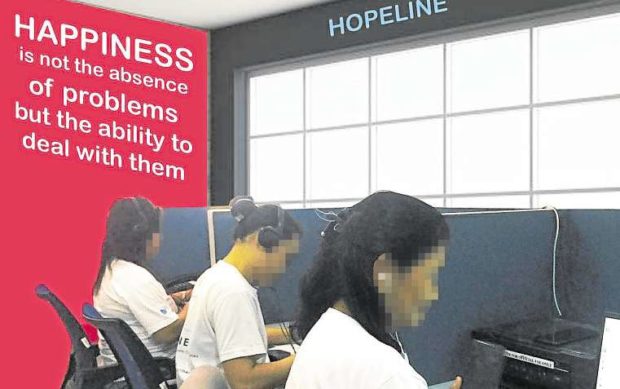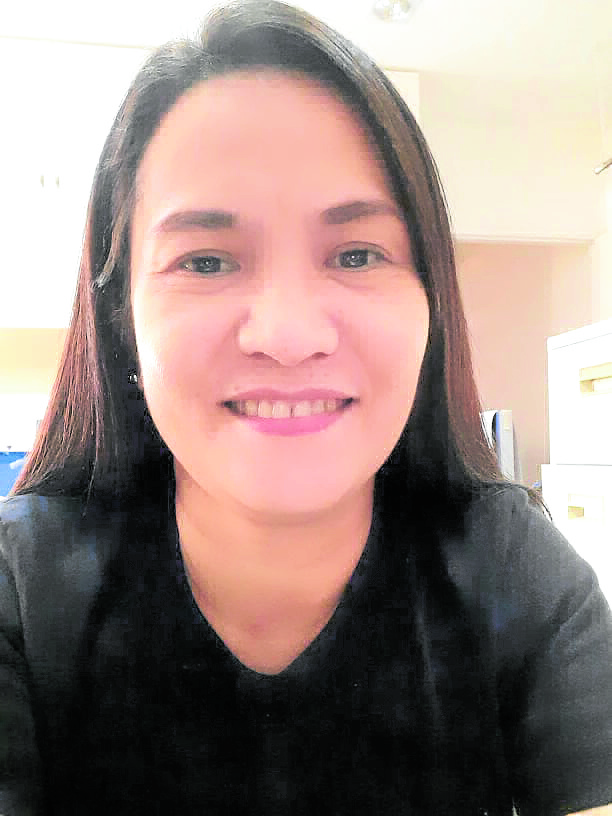Fashion designer Jeannie Goulbourn lost her beloved daughter Natasha to suicide in 2002. Since then, she has devoted her life to mental health awareness and suicide prevention in the Philippines, putting up the Natasha Goulbourn Foundation, which is now known as NGF Mindstrong.
In 2012, the foundation was launching its 24/7 emotional crisis and suicide prevention hotline. Over a thousand people applied to become part of the first batch of responders. Milagros Rollinas was one of them.
Rollinas, who has a degree in social work, had spent nine years in child protection. Wanting to explore other aspects of being a social worker, she thought about trying to be a crisis responder.
She succeeded, becoming one of the first 15 responders of Hopeline.
Nine years later, Rollinas is Hopeline’s program head. But she still can’t forget the calls from her first day as a responder. “One of my first callers was a battered wife. She was suicidal. She was mentally drained and she wanted to get out of the relationship.”
Before responders are allowed to answer calls at Hopeline, they go through an intensive training process. “It’s about mental health, depression, suicide, crisis response, counseling, crisis intervention, self-care,” says Rollinas.

And when she says the training is intensive, she really means it. They go through simulation activities and mock calls, learning counseling techniques and the proper ways to respond, before they go through two weeks of on-the-job training. “You’ll be beside team leaders or senior responders who will coach you through the process.”
Training is crucial, Rollinas says, because “you have to be confident when you respond to a call.”
Self-discovery is important, too. Responders are taught to deal with their own baggage—they have to resolve their own issues first. Rollinas says, “Kailangan wala kang bagahe kasi there will come a time, especially when you’re tired and there are a lot of calls, na talagang mati-trigger ka.”
Deluge of calls
A responder’s shift usually lasts eight hours. But when there’s a deluge of calls, sometimes they end up extending up to 10 or 12 hours.
Some calls are short, Rollinas says. “Sometimes people just call to inquire or to vent. Those calls would last from 10 to 15 minutes.”
Then there are what they refer to as moderate calls—people who are struggling, who may have suicidal thoughts, but not enough to be considered high-risk.
It’s the high-risk calls that usually last the longest and are the most challenging to handle.
Rollinas remembers receiving a call from a man who was around 80 years old. He was suicidal and he already had a gun in his hand. “Magsu-suicide siya because he was lonely. His kids were all abroad and they seldom called para mangumusta.”Rollinas spent over an hour with the man on the phone, encouraging him to recall his happy moments, to remember what it was like in the early days of his courtship with his wife. Eventually, she convinced him to put the gun away. “It was important that I establish his safety,” Rollinas says.
By the time the call ended, the man was cheerful and was making jokes. He told her he was feeling better.
In the past, each responder could expect to receive 8 to 10 calls each shift. But the pandemic has multiplied these numbers.
“Nag-peak kami talaga. Nag-300-percent increase in calls. Ang dami kasing nagpa-panic, natatakot.” They get calls from people who lost their jobs, who are struggling with blended learning, who are having difficulty with adjusting to being confined at home.
Sometimes, in a day, a responder would get three to four high-risk calls. So by the end of the shift, they would be exhausted. “Talagang drained ka. Very tiring siya psychologically,” Rollinas says.

The people of NGF Mindstrong make sure they care for their Hopeline responders. They have psychologists and psychiatrists who lead debriefing sessions, whether individually or in groups. They also have learning sessions. “The difficult cases are discussed, anong strategies ’yung gagawin, the proper terminology. Your choice of words is so important because a single word can be someone’s trigger factor. Minsan mumurahin ka na n’un,” says Rollinas.
Buddy system
They have a buddy system in place, too. And this system was crucial on a day Rollinas received a call from a man who said he was at an LRT station ready to jump in front of the next oncoming train.
“When you’re a crisis responder, you have to use your senses. You have to listen not just to the caller but their surroundings. ’Pag mahangin, ibig sabihin baka nasa roof deck,” Rollinas says.
When she asked the man where he was, he said he was at the platform at the Doroteo Jose station. He had a fight with his wife and he wanted to end his life. “Tatalon na ako, ma’am, ’pag may dumaan na tren,” he told Rollinas.
So while Rollinas was talking to him, she was instructing another crisis responder—her buddy—to contact officials at that LRT station to tell them what was going on.
Rollinas convinced the man to move away from the platform, telling him she couldn’t hear him well. “Sabi niya, ‘Hindi na, ma’am, wala nang saysay yung buhay ko, tatalon na ako. I told him, ‘The mere fact na tumawag ka sa Hopeline means gusto mo pang mabuhay.’”
She kept him on the phone, letting him talk, cry, shout. “Naglabas siya ng sama ng loob niya.”
The man calmed down eventually and Rollinas spoke to a guard at that LRT station to keep an eye on him and allow him to stay there for a bit while he composed himself.
Some calls can really be draining, Rollinas says. “Minsan nakikipag-battle ka. You have be alert. You have to be three, five steps ahead.”
We may never know the exact number of lives Hopeline has saved, but we know it will be saving more.
Hopeline callers’ ages range from 10 to 95. Kids often call because they’re affected by seeing their parents fighting. Sometimes, parents would use the redial button to find out who their kids have been calling.
One time, a Hopeline responder received a call from a 7-year-old kid who was alone at home and needed help with his homework.
Need for funding
With Hopeline’s new system, Hopeline responders are able to stay safe and work from home, reporting to the office only once a week. “Naka-Cloud na kaming lahat,” says Rollinas. “The responders use group chats to communicate and ask help from one another.”
Hopeline has 20 responders now—a mix of social workers, psychologists, psychiatric nurses, teachers—but Rollinas says with the increase in the number of callers, they really need more people, thus the need for funding.
“Getting support is really a challenge,” she says. “We really look for funding to support the operations. It’s a free service but, of course, we have operational costs.”
Nine years since she started, Rollinas remains passionate about what she does at NGF Mindstrong and Hopeline. “It’s really fulfilling, knowing that you’re helping other people. People tell you, ‘Thank you for saving my life,’ ‘Thank you for giving me another chance.’” For her, being a crisis responder isn’t just a job, it’s a mission.
And right now, part of that mission is making sure Hopeline keeps going, by finding donors who are willing to help—both companies and individuals.
Goulbourn said, “We hope companies will see the value of why Hopeline is needed. We are also very happy to get the youth and caring and concerned citizens who keep this initiative going to serve the mental challenges that people are undergoing. According to statistics, 43 percent of people are reaching the line of moderate depression because of fear and the anxiety from the uncertainty of the future. Kaya natin ito, buhat natin ang pag-asa.”
Hopeline has the 10 Piso Mula Sa Puso campaign where people can use GCash to donate to the hotline. (The QR code is on www.facebook.com/HopelinePH.)
Rollinas says, “We say your P10 can save a life. People really need someone to talk to, lalo ngayong pandemic. People call us seeking hope. Paano yung mga taong naghihintay ng hope sa Hopeline? ” INQ
Need help? Contact Hopeline at tel. 2919 or 0917-5584673 (Globe/TM), 0918-8734673 (Smart), 88044673 (PLDT). Visit ngf-mindstrong.org.








































